Resident Crews of the Mir
![]()
Mir: Expedition 1 |
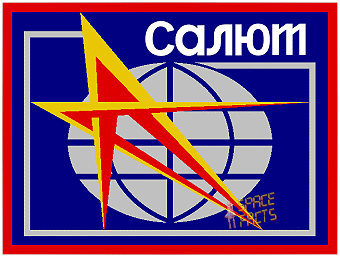 |
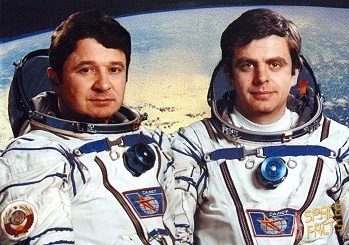
alternative crew photo |
|
alternative crew photo |
alternative crew photo |
alternative crew photo |
alternative crew photo |
alternative crew photo |
alternative crew photo |
![]()
Crew, launch- and landing data
| No. | Nation | Surname | Given names | Position | Spacecraft (launch) |
Launch date |
Launch time |
Spacecraft (landing) |
Landing date |
Landing time |
Mission duration |
Orbits |
| 1 | Kizim | Leonid Denisovich | Commander | Soyuz T-15 | 13.03.1986 | 12:33:08.879 UTC | Soyuz T-15 | 16.07.1986 | 12:34:05 UTC | 125d 00h 00m 56s | 1980 | |
| 2 | Soloviyov | Vladimir Alekseyevich | Flight Engineer | Soyuz T-15 | 13.03.1986 | 12:33:08.879 UTC | Soyuz T-15 | 16.07.1986 | 12:34:05 UTC | 125d 00h 00m 56s | 1980 |
Backup Crew
| No. | Nation | Surname | Given names | Position |
| 1 | Viktorenko | Aleksandr Stepanovich | Commander | |
| 2 | Aleksandrov | Aleksandr Pavlovich | Flight Engineer |
Expedition Report
|
Launch from the Baikonur Cosmodrome and
landing 55 km northeast of Arkalyk. The Mir core module or base block was launched on February 20, 1986 on a Proton-K rocket from at the Baikonur Cosmodrome. It had a mass of about 21 tons, a length of about 13.1 meters, and a maximum diameter of 4.2 meters. The Mir core module was the backbone of the Mir space station. Derived from the prior Salyut 6 and 7 space stations, it acted as the principal space station control element and contained the main computers, communications equipment, kitchen and hygiene facilities, and primary living quarters. The module provided 90 cubic meters of habitable volume. The core module included six docking ports used as permanent attachment points for the other station modules and for temporary docking of manned and unmanned resupply ships. Although the core module's main propulsion system had not been operational since the arrival of Kvant1, the core acted as the principal propellant storage unit and assisted in controlling the attitude of the entire space station. The core was divided into four compartments, designated as the working, transfer, intermediate and assembly compartments. All but the assembly compartment were pressurized. A small airlock was also available for experiments or for the release of small satellites or refuse. The working compartment was the main habitable volume on Mir and consisted of two concentric cylinders connected by a tapered conical section. The interior of the working compartment was divided into an operations zone and a living area. The operations zone occupied the smaller diameter section and was the control area for the entire Mir complex. Monitoring and commanding of the core systems, scientific equipment and mechanisms were carried out in this area. The living area of the working compartment provided the necessities for long-term manned missions and contained a galley area, individual crew cabins, hygiene facilities and trash storage. Medical monitoring equipment and a bicycle ergometer were located in the conical portion of the working compartment. The spherical transfer compartment was located at the fore end of the working compartment. It provided radial docking ports, spaced at 90-degree increments, for 4 of the station's added modules with a 5th additional axial docking port for visiting transport craft. Access to the additional station modules was provided through the transfer compartment. The intermediate compartment was a 2-meter diameter pressurized tunnel that connected the working module to the aft docking port. The tunnel was located in the center of the non-pressurized assembly compartment. The aft docking port was used for visiting transport vehicles until permanently occupied by the Kvant1 module. Main engine and fuel tanks were located in the non-pressurized assembly compartment. This annular space contained the main engine and fuel tanks. Externally, this assembly supported the station's satellite relay antenna, docking radar antennas, lights and optical sensors. Power to the core module was initially provided by 2 38 sq. meter arrays providing 9 kW. A 3rd array was added to the core in 1987 to bring total power to 10.1 kW. Additional power from visiting Progress M and Soyuz TM vehicles and other station modules could be added to the station's total supply. The core contained 12 NiCd batteries for power storage. The core was also equipped with 32 137 N attitude control thrusters and 2 2.9 kN thrusters for orbit maintenance (useless while Kvant1 was attached). The propulsion system was a pressure fed UDMH/NTO system. Life support system maintained the station's environment at 18-28 deg. C and 20-70 percent humidity. An electrolytic system was used to recycle station atmosphere with a backup chemical scrubbing system. Station pointing could be controlled to within 15 arcmin. 2 primary CPUs provided most station control functions. Star sensors, IR Earth horizon sensors, sun sensors, magnetometers, gyros, accelerometers were used for attitude determination. Communication with the ground was via 11-14 GHz links through geosynchronous relay satellites. Following a two-day solo flight Soyuz T-15 docked with the new space station Mir on March 15, 1986. Plans for Mir intended that only the newer Soyuz TM would dock with Mir's forward port, leaving the aft port free for arriving Progress spacecraft. However, the older Soyuz T actually used for the first Soyuz T-15 mission to Mir was not equipped with the Kurs approach system used on Mir's front port, but only with the older Igla approach system used for Mir's aft port. Therefore, Soyuz T-15 had to approach Mir's aft port, and then manually maneuver around the station to dock manually at the forward port. At 20 km Soyuz T-15's Igla system acquired its counterpart on Mir's aft port. At 200 meters, the Igla system was shut off, and the crew manually maneuvered around the station to dock at the front port. For this manual approach, the same laser range finder was used as for the Soyuz T-13 docking with the uncooperative Salyut 7 station in 1985. The cosmonauts became the first resident crew of Mir. The Progress 25 resupply ship was docked to Mir from March 21, 1986 - April 20, 1986. Meanwhile the first tests of the Soviet data and voice relay system, the Altair/SR system, were conducted on March 29, 1986 using Mir's large aft antenna and the geosynchronous Cosmos 1700 satellite. Rezonans tests. The Mir-1 crew conducted Rezonans tests of the Soyuz T-15-Mir base block-Progress 25 complex on March 31, 1996. The Mir-1 crew subjected the Mir base block-Soyuz T-15 assemblage to further Rezonans tests after the departure of Progress 25. They also for the first-time placed Mir in gravity gradient stabilization mode, with its long axis pointed toward the center of the Earth, and tested the station's atmosphere. Progress 26 was docked to the station from April 26, 1986 - June 22, 1986. The freighter rendezvoused with Mir on April 25, 1986, but problem with Mir's radio communication system delayed docking until the next day. It docked with Mir on April 26, 1986 at 21:26:06 UTC and undocked on June 22, 1986 at 18:25:00 UTC. In preparation for the trip to Salyut 7, the crew loaded Soyuz T-15 with their personal belongings, plants grown on Mir, and other items. At that time Salyut 7 was still 4000 km ahead of Mir in a lower orbit. Therefore, on May 04, 1986 Mir was lowered by 13 km in order to speed the approach to Salyut 7 and conserve Soyuz T-15's limited fuel supply for the transfer. On March 05, 1986, they undocked from Mir for a day long journey to the Salyut 7 space station and stayed there for 50 days as sixth resident crew. While Soyuz T-15 was away, Soyuz TM-1 docked to Mir from May 23, 1986 - May 29, 1986. Just as Soyuz-T represented a Soyuz upgrade for Salyut 7, Soyuz-TM represented an upgrade for Mir. Soyuz TM-1 arrived unmanned at the unoccupied station and remained for 9 days. The Progress 26 freighter was automatically commanded to depart the station on June 22, 1986. Mir maneuvered twice June 24, 1986 and June 25, 1996, raising its orbit slightly and moving closer to Salyut 7. After done work the crew returned to the Mir space station on June 26, 1986 in a 29-hour journey. It was the first transfer from one space station to another space station in space history. When back on Mir Leonid Kizim and Vladimir Soloviyov installed there some systems taken from Salyut and they performed some scientific experiments. One of these experiments was GEOEX 8, in which some areas of the German Democratic Republic were explored by an airplane, a satellite and from space. This was useful for agriculture, geology and environmental protection. Before returning back to Earth the crew put the Mir into an automatic working modus. The Soyuz spacecraft is composed of three elements attached end-to-end - the Orbital Module, the Descent Module and the Instrumentation/Propulsion Module. The crew occupied the central element, the Descent Module. The other two modules are jettisoned prior to re-entry. They burn up in the atmosphere, so only the Descent Module returned to Earth. Having shed two-thirds of its mass, the Soyuz reached Entry Interface - a point 400,000 feet (121.9 kilometers) above the Earth, where friction due to the thickening atmosphere began to heat its outer surfaces. With only 23 minutes left before it lands on the grassy plains of central Asia, attention in the module turned to slowing its rate of descent. Eight minutes later, the spacecraft was streaking through the sky at a rate of 755 feet (230 meters) per second. Before it touched down, its speed slowed to only 5 feet (1.5 meter) per second, and it lands at an even lower speed than that. Several onboard features ensure that the vehicle and crew land safely and in relative comfort. Four parachutes, deployed 15 minutes before landing, dramatically slowed the vehicle's rate of descent. Two pilot parachutes were the first to be released, and a drogue chute attached to the second one followed immediately after. The drogue, measuring 24 square meters (258 square feet) in area, slowed the rate of descent from 755 feet (230 meters) per second to 262 feet (80 meters) per second. The main parachute was the last to emerge. It is the largest chute, with a surface area of 10,764 square feet (1,000 square meters). Its harnesses shifted the vehicle's attitude to a 30-degree angle relative to the ground, dissipating heat, and then shifted it again to a straight vertical descent prior to landing. The main chute slowed the Soyuz to a descent rate of only 24 feet (7.3 meters) per second, which is still too fast for a comfortable landing. One second before touchdown, two sets of three small engines on the bottom of the vehicle fired, slowing the vehicle to soften the landing. |
Photos / Graphics
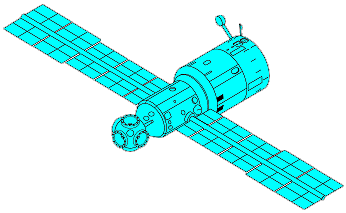 |
 |
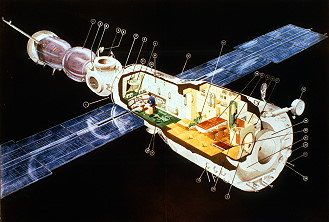 |
 |
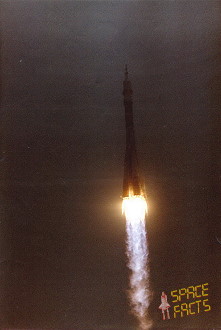 |
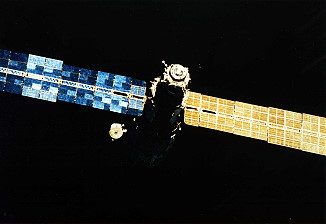 |
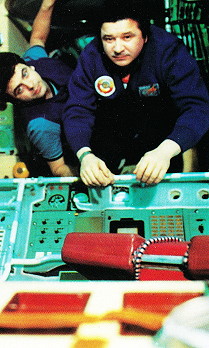 |
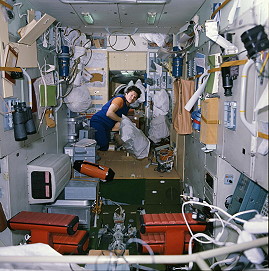 |
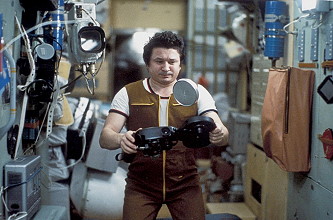 |
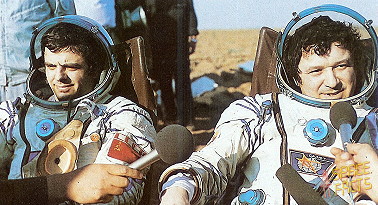 |
| © |  |
Last update on August 26, 2024.  |
 |